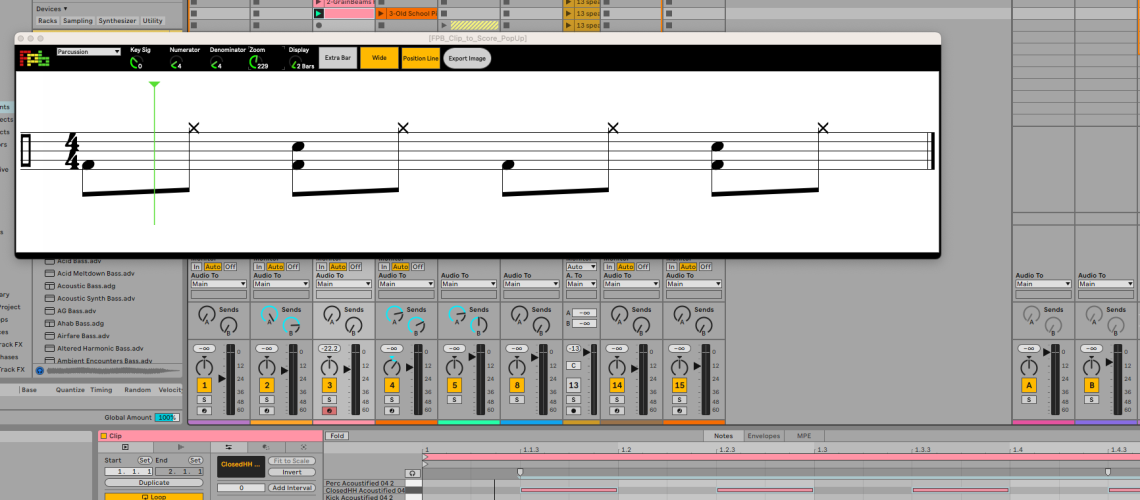Ableton Live has never had a built-in notation view, but one intrepid developer has created one in Max – and it’s free/donation- and community-supported. And it works beautifully.
The history of the computer DAW is bound up with music notation. The predecessor of what is now Apple Logic Pro was originally developed as [C-Lab] “Notator.” The notational views in tools like Cubase and Logic trace their lineage back to those early computer notation tools; Avid integrated notation in Pro Tools after acquiring Sibelius. For those who read music and for musical ideas that fit Western notation, scores remain a useful means of visualization. (Not to mention, by the time you’re working with Max, you can also envision other notational systems!)

I expected FBP Clip To Score to be a crude hack/workaround, but it works beautifully, especially after the major 0.6.7 update that just dropped. It’s got some heuristics to adapt to the correct track (hint: you’ll want to make sure you’re naming what you’re making). Then it will select clef, voice assignment, multiple voices, and, crucially for those of us working with a lot of percussion, Drum Kit to Score.
All of this works seamlessly – with occasional interventions in how it’s set up or how you’ve named your parts. Instantiate the Max for Live plug-in, click open pop-up, and you get a floating window with a view of the actively playing clip. Select a clip, and that window will follow playback – even the cursor.
This is nowhere near as mature as the tools in Logic, Cubase, or Pro Tools, but it does work in a pinch – and it’s frankly mind-blowing to me that this was built in Max. Here it is doing a decent job of splitting piano voices:

Rhythm tracks work, too. By default, it seems they bring up a percussion clef, but that can place the pitches in odd registers; in my case, at least, I had to bring up the particular percussion part I wanted and then I got a usable view. In this example, I selected “clap” from the clef dropdown on the upper left (just to the right of the logo). Notice also options for key signature, meter, and display.

The biggest surprise is the awesome image export. It’s described as “basic,” but it’s also incredibly fast—grab any clip, and you can quickly export a PNG. That could be a real godsend for many compositional and educational tasks.

Installation notes
If you jumped in without reading the requirements, you may have seen something like this:

For the moment, this tool is in development and comes without documentation. But here’s a hint on installation. You need to install the bach “automated composer’s helper” tool for Max, a free and open source tool developed as a research project by Andrea Agostini and Daniele Ghisi. (It’s also donation-supported, with a Patreon account.)
From the Max interface, choose File > Show Package Manager, and type “bach” in the search field. Then install bach, restart Max when prompted, and restart Ableton Live. (It seems otherwise Max for Live won’t load bach’s needed fonts.)

That does it! I think this may work from Max for Live even if you don’t have a Max 8 license, but I’m not entirely certain as I didn’t test it.
Notation and Max and Pd

This project is great, but it’s also an excuse to talk about bach, cage, and dada. If this was all a little too Western / concert / classical for you, bach has companion tools covering 20th- and 21th-century notations / extended notations (cage), and an open box generative graphic tool (dada). In the case of dada, you can program the notational system however you like. All three offer various other interactive and generative features beyond just what you see here, and of course that’s in turn in the Max patching environment, so you have essentially an open canvas.
Check that out: https://www.bachproject.net/#family
That’s a topic for another time, but I’ll let you explore – check the projects page for ideas like the one pictured.
And if you liked this, you should also know about the free and open-source ClickTracker, which lets you easily produce cues and click tracks – both of which can still be vital in computer music across genres as you mix players with your electronic productions. I’ve written about that before:
It’s constantly getting updates and available for multiple platforms (including Max and Pd), desktop and mobile:

ClickTracker website and desktop version
And a useful library for players and conductors
Let us know what you do with these and what you think; happy scoring/composing/playing!




